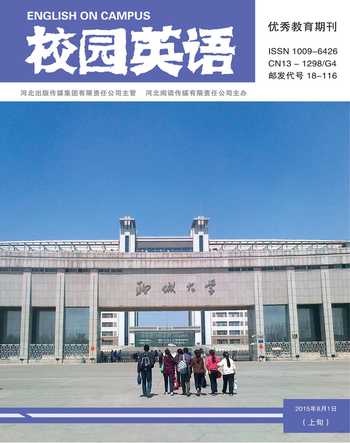話語標(biāo)記語的位置語用研究
張彩燕
一、標(biāo)記性語言的含義話語標(biāo)記語(discourse markers)又稱話語聯(lián)系語 (discourse connectives),就是表現(xiàn)句子結(jié)構(gòu)的一個(gè)單詞或者詞組,它是依存于前言后語,劃分說話單位的界標(biāo),位置不固定,可在句子的開頭、中間或者結(jié)尾,話語標(biāo)記語為進(jìn)行中的話語提供了語境坐標(biāo),它表明了語句與前面或后面的話相聯(lián)系,或者與前后同時(shí)相聯(lián)系。如類似下面斜體加粗部分的詞語或結(jié)構(gòu):1.We were late in leaving office.Nevertheless,we arrived on time.2.It is my fault .After all,you are the boss.3.A:Good morning,F(xiàn)red,I hope you ve recovered from your illness.B:Yes,thank you.Er —well,not fully,but I m on the mend.4.Vivian: what do you do anyway?Myth: I am a writer,I guess. 話語標(biāo)記語包括部分連詞如 and、therefore、so等,副詞如actually、really、unfortunately等,感嘆詞如oh、well、ok等及某些短語如you see、you know、as a result of等。它們所傳遞的不是句子意義或語義意義,也就是說它們實(shí)際上沒有詞性意義,而是為話語理解提供信息標(biāo)記,從而對(duì)話語理解起引導(dǎo)作用。 二、話語標(biāo)記語的用法1.用于開頭(1)意示對(duì)前面所說內(nèi)容的認(rèn)同 如:right,okay,all right,I see,I know等舉例:Vivian: Today Betty wears a new beautiful skirt.May: I know,she is dating with a boy resently.Lily: Mom,I want to go to paly football.Mom: Okay,but be careful.(2)意示前面所說內(nèi)容改變了自己原有的認(rèn)知,如oh,ah等舉例:Vivian: I heard that Mark failed the exam. May: Ah,I thought he would succeed.Olia: Mr.Huang married a business woman.David: Oh,I remember he wanted to marry a teacher.(3)意示在無準(zhǔn)備或不得已情況下接替他人的話,如:well舉例:1)意示與前面所說的話作一了斷并開始自己的話 如well,all right,okay等舉例:①Teacher: (when hearing the bell ring) Well,let s begin our class.② A: I have many chocolates.B:Well,how much did you pay for that?2)在當(dāng)前話題中間轉(zhuǎn)移話題 如 well,okay,right等舉例:Vicky: Can I drive you to office?David: No,thanks a lot.The bus is just up the street.It won t take me long at all.Vicky: Well,you really saved the day for me,David.2.用于中間 (1)表示偏離主題,突發(fā)的想法,自我修補(bǔ)等如I mean,w ell,oh,right等舉例:Lily: Dear,what do you think of this dress?Mart: Hurry up.We are late for the party.(at the same time,the wife is angry.) I mean this dress is fit for you.Come on.(2)意示語氣含糊,對(duì)所說的話不夠肯定或者要負(fù)責(zé)任的程度較低如like,just,a bit,sort/ kind of,well,or something,not really,and everything/things/ stuff/that,I think等舉例:A:Good morning,David,I hope youve recovered from your illness.B: Yes,thank you.Er —well,not fully,but I m on the mend.A: What do you think of tonight speech,Lily?B: I think it is kind of boring.I saw many audiences fell asleep during the speech.3.用于結(jié)尾(1)意示話題即將結(jié)束。如 and everything/ things/ stuff/that,or something等舉例:Im more into things like going to museums,concerts,and that kind of thing.You bored or something?(2)意示要對(duì)方認(rèn)同自己的話語。如I guess,I suppose,I m sure,you know,you see,okay,right等舉例:1) Holly: what do you do anyway?Paul: I am a writer,I guess.2) Uncle: Now you know what you are doing,I suppose.Roy: Yes,sir.You'd be proud of her too,sir.I m sure.本文介紹了話語標(biāo)記語的概念,并嘗試從話語標(biāo)記語的不同位置來進(jìn)一步闡述其用法。 話語標(biāo)記語是日常會(huì)話中的一種十分常見的話語現(xiàn)象,其作用是豐富多彩的。總的而言,話語標(biāo)記語可從局部上或整體上對(duì)他人的話語理解起著引導(dǎo)或指示的功能,幫助聽話者更好地識(shí)別話語所要表達(dá)的意思。參考文獻(xiàn):[1]程海燕,陳蕓.話語標(biāo)記的功能[J].牡丹江教育學(xué)院學(xué)報(bào),2005.[2]李民,陳新仁.英語專業(yè)學(xué)生習(xí)得話語標(biāo)記語WELL語用功能之實(shí)證研究[J].外語教學(xué)與研究,2007:21-26.

